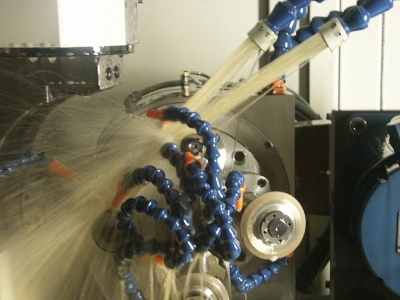
Whether miniature instruments for endoscopy or tiny mechatronic components in automobiles - the demand for microcomponents in all areas of daily and industrial life is constantly increasing. At the same time, there is a growing need for high-precision miniature tools to produce these delicate products. Fine filtration of metal coolants plays a special role in the overall machining process and is a prerequisite for production of these items. The slightest contamination of the grinding oil or small temperature variances can have a negative impact on finished part quality. The filtration system manufacturer VOMAT offers ultrafine filtration systems with high control accuracy that provide clean coolants in NAS 7 quality and are particularly well-suited for the production of miniature tools.
Micro tool makers need to produce extremely high-quality cutting edge surfaces and precise concentricity. To reliably grind drills, cutters and gages with wafer-thin shanks and exacting geometries in large quantities; production conditions, technologies and comprehensive quality assurance must all work together harmoniously. State-of-the-art grinding, measuring and edge preparation technology - ideally in temperature-controlled production facilities - complement each otherand result in miniature tools whose surface quality and concentricity meet the extreme requirements .
"The missing piece in these highly sensitive production conditions is the fine filtration of cooling lubricants" says Steffen Strobel, technical sales manager of VOMAT from Treuen/Germany. "Especially when grinding microtools, contaminated or poorly filtered coolant can seriously influence the grinding result. Even minimal temperature fluctuations in the cooling medium can lead to quality failure. VOMAT technology is designed to eliminate the negative impact that these factors can impart on finished quality."
VOMAT full-flow filtration systems separate dirty and clean oil 100 percent. You can be assured the grinding operation always receives pure coolant. In addition, VOMAT systems back flush automatically when needed. To achieve this, the degree of contamination for each individual filter element is monitored. Once a defined value is exceeded, the PLC controller automatically initiates the backwashing process for that element. The other filter elements ensure a continuous clean oil supply in NAS-7 (3-5 µm) quality. This advanced control of filter capacity as well as energy consumption has a positive effect on operating costs.
Strobel said: "The cooling of the grinding medium is very important and must be controlled precisely in very small increments. VOMAT systems have precise temperature controls which allow us to keep the grinding oil temperature in a range of ±0.1 K depending on the cooling concept. Since the oil temperature is well controlled the machine spindles do not expand. Even in the machine’s grinding area, the temperatures always remain constant. This in turn helps contribute to making tight-tolerance, high-quality finished parts."
VOMAT filter systems can be adapted to the specific needs and special production conditions of the tool manufacturer. An example of this is the cooling concept: The smaller Vomat systems, including the popular FA 240, have an optional slide - in cooling unit. This allows for easy serviceability on site. The condenser on these units is mounted in the hinged hood of the machine allowing for a very compact footprint. In addition, external condenser cooling units are available for the Vomat FA 120 to 960 series with cooling capacities from 9 to 60 kW and control accuracy of ±0.1 K or alternatively ±1.0 K at ambient temperatures of 15° C to 35° C so you can choose the system that best fits with your needs.
Another option is cold water cooling with an external water circuit. Strobel states: "If cooling of the axis drives, spindles, and motors is necessary, modular units can be hooked up to the filter system. The Vomat KWS 250 is a modular and expandable chiller with an integrated frequency controlled coolant circulation pump and Eaton compact controls. The cooling capacity is 250 kW and has a control accuracy of ±1.0 K. No buffer tank is required for the unit and it can be installed instead of a cold water system.
"If a tool manufacturer relies on state-of-the-art technology when grinding micro-tools, he cannot dismiss modern and future-oriented fine filtration. This is the only way he can produce the high qualities the industry demands today."
Contact Details
Related Glossary Terms
- coolant
coolant
Fluid that reduces temperature buildup at the tool/workpiece interface during machining. Normally takes the form of a liquid such as soluble or chemical mixtures (semisynthetic, synthetic) but can be pressurized air or other gas. Because of water’s ability to absorb great quantities of heat, it is widely used as a coolant and vehicle for various cutting compounds, with the water-to-compound ratio varying with the machining task. See cutting fluid; semisynthetic cutting fluid; soluble-oil cutting fluid; synthetic cutting fluid.
- edge preparation
edge preparation
Conditioning of the cutting edge, such as a honing or chamfering, to make it stronger and less susceptible to chipping. A chamfer is a bevel on the tool’s cutting edge; the angle is measured from the cutting face downward and generally varies from 25° to 45°. Honing is the process of rounding or blunting the cutting edge with abrasives, either manually or mechanically.
- grinding
grinding
Machining operation in which material is removed from the workpiece by a powered abrasive wheel, stone, belt, paste, sheet, compound, slurry, etc. Takes various forms: surface grinding (creates flat and/or squared surfaces); cylindrical grinding (for external cylindrical and tapered shapes, fillets, undercuts, etc.); centerless grinding; chamfering; thread and form grinding; tool and cutter grinding; offhand grinding; lapping and polishing (grinding with extremely fine grits to create ultrasmooth surfaces); honing; and disc grinding.
- quality assurance ( quality control)
quality assurance ( quality control)
Terms denoting a formal program for monitoring product quality. The denotations are the same, but QC typically connotes a more traditional postmachining inspection system, while QA implies a more comprehensive approach, with emphasis on “total quality,” broad quality principles, statistical process control and other statistical methods.







